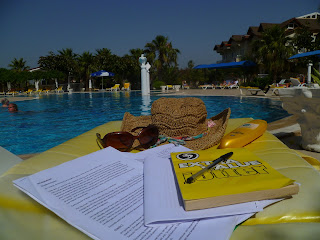 This is a holiday blog, conceived during our week in the lovely Dalyan in South-West Turkey, which means a) you need to be a bit forgiving - I was on holiday after all, and as I write this, I am barely awake, having arrived home at 2.30am this morning; and b) it reflects my holiday reading. You can see from the photograph that even at the poolside, writing was never far from my thoughts.
This is a holiday blog, conceived during our week in the lovely Dalyan in South-West Turkey, which means a) you need to be a bit forgiving - I was on holiday after all, and as I write this, I am barely awake, having arrived home at 2.30am this morning; and b) it reflects my holiday reading. You can see from the photograph that even at the poolside, writing was never far from my thoughts.Looking for holiday books that might help with my own writing, I chose Secret Smile by Nicci French because it is a tightly written thriller by a hugely successful husband and wife team. Sceptical at first, I was soon swept up in the well-drawn characters and fast-moving, hard to predict plot. My second holiday book was Grave Secrets by Kathy Reichs - another thriller, in the forensic scientist tradition of Patricia Cornwell. I picked this up in the hotel's stash of left-behind literature and I chose it mainly because it wasn't in German. This was also a good thriller and had me turning pages by the pool, though the irony was not lost on me that here I was, on holiday to relax and recuperate, sitting in the Turkish sun and reading in exhaustive detail about our heroine's retrieval of human remains from a septic tank.
What struck me in both books is how important the detail is. This was something that came up when my novel, Unspeakable Things, was assessed by a writing consultant, who delivered a wonderfully detailed report that has been invaluable to me in this rewrite. Writing about the lack of detail in my draft, in particular about setting, she wrote: 'A modern reader wants less of it than a Victorian reader would; some people close a book if they see more than the bare minimum of description. What you want isn't bulk, but a few telling details.' During this rewrite, I have been very much aware of the need for those 'few telling details'.
What struck my in both of my holiday reads was the importance of detail, in particular about food and the heroines' clothes and grooming details. Nicci French's heroine, Miranda, is forever deciding what to eat, cooking, popping into cafes and making herself hot buttered toast. During the phase when she was staking out a cafe and kept ordering hot drinks and cakes in order to blend in with the clientelle, there was so much compelling food detail that I found I was beginning to worry for her health. Dr Temperance Brennan in Grave Secrets must be permanently on a caffeine high, given the amount of coffee she takes in during a novel's worth of forensic sleuthing. With both of these main characters, there is also a lot of detail of the clothing choices made – even as the plot thickens and we wonder what a new day holds for our heroine, we are told what outfit she throws on before heading out of the door to find out.
In the case of Grave Secrets, detail is part of what the author has to offer; as a forensic anthropologist herself, Kathy Reichs can ground her story in the facts of her science. Yet I came to realise, reading by the pool, that in it is not just this occupational detail that creates the texture of everyday reality in fiction; it is the apparently incidental detail of food eaten, clothes worn, faces splashed with water and teeth cleaned that help to create a fictional reality and a pleasurable immersive experience for the reader. As in life, food and clothing add colour and interest, and even provide a kind of comfort. In Grave Secrets, no grim detail of fleshly putrefaction or genocidal horror is spared us, and it is a strange kind of relief to learn how long Dr Tempe soaks in the bath after a day's work, how vigorously she cleans her teeth, and how she dabs on a bit of lipstick and goes out to enjoy a Guatemalan meal at a restaurant. As we accompany Miranda Cotton in Secret Smile on a tough thriller-style journey in which her life unravels, we take consolation in the cappuccinos she orders, comfort eat lemon drizzle cake alongside her and spread plenty of butter on our hot, fictional toast.
Inspired, I have begun to consider the food choices of my novel's characters. Sarah, a control freak, would surely watch what she eats. What was she cooking when she left a meal on the stove and went to do a pregnancy test - what set off the smoke alarm and had Jim running to find her? Organic chicken and brown rice? What would Jim's family eat - and could this provide the details of class contrast I have been looking for - perhaps KFC buckets that Sarah would disapprove of? Perhaps Pat would try to get Bob to watch his cholesterol and he would say that you don't live longer if you stop eating fry ups; it just feels longer.
My holiday reading has shown me that detail creates the texture of reality for us as we read, and that food is essential to fiction as it is to life.
No comments:
Post a Comment